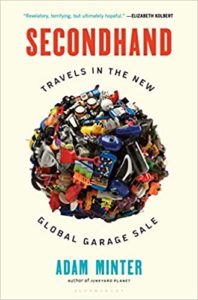Secondhand: Travels in the New Global Garage Sale by Adam Minter is a fascinating look at what happens to people’s stuff when they no longer want or need it.
The first couple of chapters discuss people decluttering on their own or disposing of a deceased family member’s belongings, often by bringing in a service to go through the stuff and determine what can be sold or donated and what should simply be thrown away.
The second part of the book goes into the global economy of second-hand stuff. For example, all the Goodwill stores in one county take unsold clothing to a Goodwill “warehouse” where clothing is sold for a dollar or two per bag; people purchase truckloads of clothing, drive over the border, and resell it at enough of a profit to make a living.
Highlights
Between 1967 and 2017, the money that Americans spent annually on stuff—from sofas to cell phones—increased almost twentyfold.
Location 51
Garage sales aren’t where it’s at anymore. Half the stuff doesn’t sell because the prices are too high. Everyone thinks they’re on Antiques Roadshow.
Location 836
In the United States (and in Europe), most secondhand goods are donated rather than sold. As a result, most people lack a financial incentive to take care of their things. So instead of seeing the end of an object’s life as an opportunity to extract some last value from it (as people do with their cars), Americans view that object in philanthropic terms. It’ll help the poor; it’ll benefit the environment. For better or worse, both those reasons have proved to be little incentive to take care of stuff.
Location 1076
None of the cut-up fragments of sweatshirt through which Wilson is rummaging were used in India. Rather, they were likely made in South Asia, exported to the United States, and worn until they were donated to Goodwill, the Salvation Army, or some other thrift-based exporter. When they didn’t sell there, they were exported again, to Kandla most likely (or perhaps Mississauga, en route to Kandla), cut up, and exported again—this time to Star Wipers in Newark, Ohio. Each step of that journey makes perfect economic sense, even if the totality of it sounds ridiculous.
Location 2755

